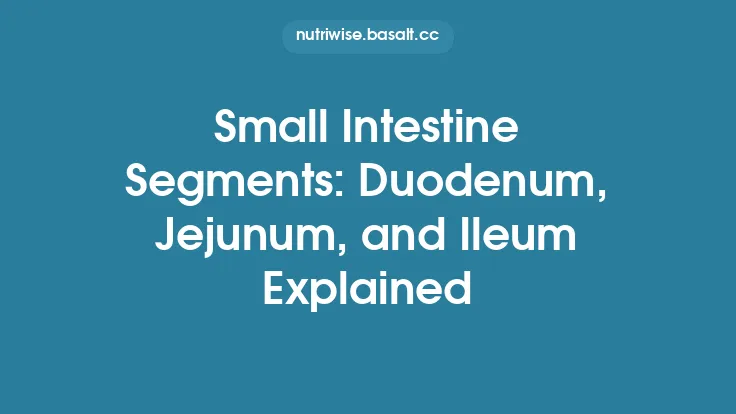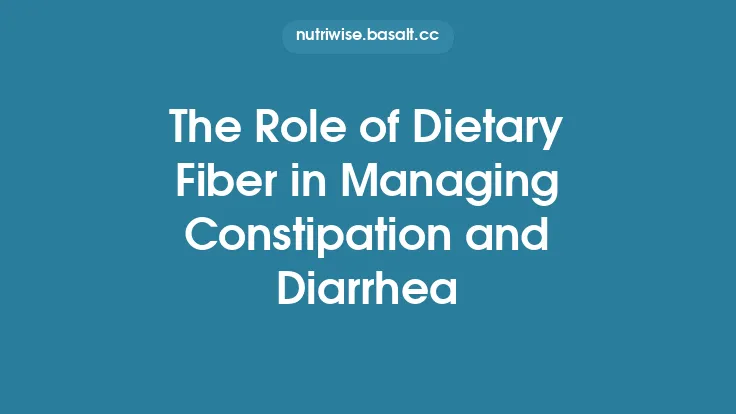The large intestine, often referred to as the colon, is the final segment of the gastrointestinal tract where the body extracts the remaining water and electrolytes from indigestible food residues, transforms them into solid waste, and prepares them for elimination. Although it occupies a relatively short length compared to the small intestine, its functional importance is disproportionate: without efficient water reabsorption and waste formation, fluid balance would be disrupted, and the risk of dehydration and electrolyte disturbances would rise dramatically. This article delves into the anatomy, cellular mechanisms, and physiological processes that enable the colon to perform these vital tasks.
Anatomical Overview of the Large Intestine
The large intestine extends from the ileocecal valve, where it receives chyme from the small intestine, to the anal canal. It is divided into several distinct regions:
- Cecum – a blind‑pouch that receives ileal contents and houses the appendix.
- Ascending colon – ascends along the right flank.
- Transverse colon – traverses the abdomen horizontally.
- Descending colon – descends along the left flank.
- Sigmoid colon – an S‑shaped segment that stores fecal material before it enters the rectum.
The colon’s wall is considerably thicker than that of the small intestine, primarily due to a more robust muscularis externa that generates segmental and peristaltic contractions essential for mixing and propelling luminal contents. The lumen is relatively wide, providing ample space for bacterial colonization and fecal bulk formation.
Histological Features Relevant to Absorption
The mucosal layer of the colon is specialized for water and electrolyte transport:
- Simple columnar epithelium – composed mainly of absorptive enterocytes, goblet cells, and a sparse population of enteroendocrine cells.
- Goblet cells – secrete a thick, bicarbonate‑rich mucus that lubricates the lumen and protects the epithelium from mechanical and chemical injury.
- Crypts of Lieberkühn – deep invaginations that house proliferating stem cells at their base; as cells migrate upward, they differentiate into absorptive or secretory phenotypes.
- Tight junctions – form a selective barrier that regulates paracellular flux of ions and water, maintaining the integrity of the epithelial seal.
Unlike the small intestine, the colon lacks villi, which reduces the surface area but is compensated by a high density of transport proteins and a longer transit time that allows thorough fluid reclamation.
Mechanisms of Water and Electrolyte Reabsorption
Water movement across the colonic epithelium is largely driven by osmotic gradients established by active ion transport. The principal steps are:
- Sodium absorption – mediated by the epithelial sodium channel (ENaC) on the apical membrane of colonocytes and the Na⁺/K⁺‑ATPase pump on the basolateral side. Sodium enters the cell passively through ENaC and is extruded basolaterally, creating a low intracellular Na⁺ concentration.
- Chloride absorption – occurs via the coupled Na⁺‑Cl⁻ cotransporter (NCC) and the chloride/bicarbonate exchanger (SLC26 family). Chloride follows the electrochemical gradient established by sodium transport.
- Potassium secretion – facilitated by apical potassium channels (e.g., ROMK) that help maintain electroneutrality.
- Water follows – osmotic water movement is primarily transcellular through aquaporin‑3 (AQP3) and aquaporin‑4 (AQP4) channels located on the basolateral membrane, and to a lesser extent paracellularly through the tight junctions.
The net effect is the reabsorption of up to 1–1.5 L of fluid per day, converting a liquid chyme into a semi‑solid mass.
Role of the Colon in Electrolyte Balance and Acid‑Base Homeostasis
Beyond water, the colon fine‑tunes systemic electrolyte concentrations:
- Sodium and chloride – their reabsorption contributes to extracellular fluid volume regulation.
- Bicarbonate – secreted by colonocytes into the lumen in exchange for chloride, helping to neutralize the acidic environment created by bacterial fermentation.
- Potassium – the colon can both secrete and absorb potassium, depending on dietary intake and hormonal signals (e.g., aldosterone).
These processes are integral to maintaining acid‑base equilibrium, especially during periods of altered dietary intake or metabolic stress.
Mucus Production and Its Protective Functions
Goblet cells synthesize a gel‑like mucus composed of mucins (primarily MUC2) that polymerize to form a dense, hydrated barrier. This mucus layer serves several purposes:
- Physical protection – shields the epithelium from abrasive fecal particles and bacterial toxins.
- Selective permeability – allows diffusion of small ions while restricting larger microbial components.
- Habitat for commensal microbes – the outer mucus layer provides a niche for beneficial bacteria, which in turn produce short‑chain fatty acids (SCFAs) that fuel colonocytes.
Disruption of mucus integrity is linked to inflammatory conditions and increased susceptibility to infection.
Microbial Fermentation and Its Impact on Waste Formation
The colon harbors a dense and diverse microbiota that ferments undigested carbohydrates, proteins, and fibers. Key outcomes of this fermentation include:
- Short‑chain fatty acids (SCFAs) – acetate, propionate, and butyrate are produced in a roughly 60:20:20 ratio. SCFAs are absorbed and serve as an energy source for colonocytes (butyrate) and peripheral tissues (acetate, propionate).
- Gas production – hydrogen, methane, and carbon dioxide are generated, contributing to luminal pressure and influencing motility.
- Vitamin synthesis – certain bacteria synthesize vitamin K and B‑group vitamins, which can be absorbed in the colon.
The metabolic activity of the microbiota also acidifies the lumen, which promotes sodium and water reabsorption via the mechanisms described earlier.
Formation and Composition of Feces
Fecal matter is a complex amalgam of:
- Water – typically 75 % of fresh stool; the remainder is removed during transit.
- Undigested dietary residues – fiber, resistant starch, and plant cell walls.
- Microbial biomass – dead bacteria constitute a substantial portion of dry weight.
- Mucus – both secreted and sloughed epithelial cells contribute to the matrix.
- Metabolic by‑products – SCFAs, bile pigments (converted to stercobilin, giving stool its brown color), and trace minerals.
The gradual dehydration and compaction of this mixture result in the characteristic solid form ready for evacuation.
Regulation of Motility in the Large Intestine
Colonic motility is orchestrated by coordinated muscle contractions:
- Haustral churning – segmental contractions mix contents, enhancing contact with the absorptive surface.
- Mass movements – powerful peristaltic waves that occur a few times daily, propelling fecal material toward the rectum.
- Neuro‑hormonal cues – while the detailed enteric circuitry is beyond the scope of this article, it is worth noting that hormones such as peptide YY (PYY) and glucagon‑like peptide‑1 (GLP‑1) modulate colonic transit time, indirectly influencing water reabsorption efficiency.
Clinical Correlates of Impaired Water Reabsorption
When the colon’s absorptive capacity is compromised, the following conditions may arise:
- Diarrhea – excessive luminal water due to reduced sodium/chloride uptake or increased secretion (e.g., secretory diarrheas caused by bacterial toxins).
- Constipation – overly efficient water reabsorption or slowed transit leads to overly dry, hard stools.
- Electrolyte disturbances – chronic diarrhea can precipitate hyponatremia, hypokalemia, and metabolic acidosis, whereas prolonged constipation may cause hypernatremia and metabolic alkalosis.
Therapeutic strategies often target the underlying transport mechanisms (e.g., oral rehydration solutions exploit the Na⁺‑glucose cotransporter to enhance water uptake).
Nutritional and Lifestyle Factors Influencing Colonic Function
Dietary composition exerts a profound effect on colonic water handling:
- Fiber intake – soluble fibers (e.g., pectin) increase luminal viscosity and fermentability, promoting SCFA production and modestly enhancing water retention. Insoluble fibers add bulk, stimulating haustral activity.
- Fluid consumption – adequate hydration supports optimal luminal volume, facilitating efficient absorption.
- Electrolyte balance – diets high in sodium can augment colonic sodium reabsorption, whereas low‑potassium diets may impair potassium handling.
- Probiotics and prebiotics – modulate microbial composition, potentially influencing SCFA profiles and mucus production.
Regular physical activity also promotes colonic motility, reducing transit time and preventing excessive water loss.
Future Directions in Research
Advancements in imaging, omics technologies, and organoid models are expanding our understanding of colonic physiology:
- Single‑cell transcriptomics – reveal heterogeneity among colonocytes, identifying subpopulations specialized for distinct transport functions.
- Microbiome‑host interaction studies – elucidate how specific bacterial metabolites regulate epithelial ion channels and aquaporins.
- Targeted therapeutics – development of drugs that modulate ENaC or aquaporin activity offers promise for treating refractory diarrhea or constipation.
Continued interdisciplinary research will refine our grasp of how the large intestine maintains fluid homeostasis and may uncover novel interventions for gastrointestinal disorders.
In summary, the large intestine is a highly specialized organ whose primary mission is to reclaim water and electrolytes, shape waste, and interface with a dense microbial community. Its intricate transport systems, protective mucus layer, and dynamic motility patterns work in concert to ensure that the body retains essential fluids while efficiently eliminating indigestible residues. Understanding these processes not only deepens our appreciation of human physiology but also informs clinical practice and nutritional guidance aimed at preserving optimal colonic health.





